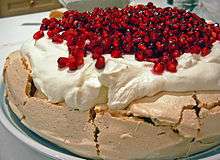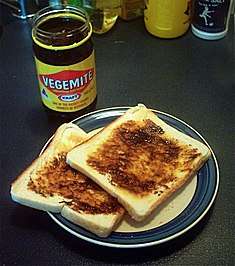Australian cuisine
Australian cuisine refers to the food and cooking practices of Australia and its inhabitants. As a modern nation of large-scale immigration, Australia has a unique blend of culinary contributions and adaptations from various cultures around the world, including Asian and European.
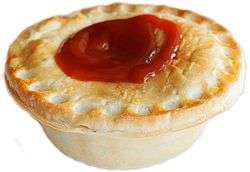
| Part of a series on the |
| Culture of Australia |
|---|
 |
| History |
|
People
|
| Languages |
|
Traditions
|
|
Mythology and folklore
|
| Cuisine |
| Festivals |
|
|
Art |
|
Literature |
|
Music and performing arts
|
|
Media
|
| Sport |
|
|
Indigenous Australians have occupied Australia for some 65,000 years, during which they developed a unique hunter-gatherer diet, known as bush tucker, drawn from regional Australian flora and fauna. Australia became a collection of British colonies from 1788 to 1900, during which time culinary tastes were strongly influenced by British and Irish migrants, with agricultural products such as beef cattle, sheep and wheat becoming staples in the local diet. The Australian gold rushes introduced more varied immigrants and cuisines, mainly Chinese, whilst post-war immigration programs led to a large-scale diversification of local food, particularly under the influence of migrants from the Mediterranean, East Asia and South Asia.[1]
Australian cuisine in the 21st century reflects the influence of globalisation, with many fast-food restaurants and international trends becoming influential. Organic and biodynamic foods have also become widely available alongside a revival of interest in bush tucker.[2] Australia has become known for the high quality of its exports, with major agricultural industries including cattle, sheep, poultry, milk, vegetables, fruit, nuts, wheat, barley and canola.[3] The country is also well regarded for its locally-made wine, beer and soft drinks.
While fast food chains are abundant, Australia's metropolitan areas have fine dining establishments that offer both local and international foods. Restaurants whose product includes contemporary adaptations, interpretations or fusions of exotic influences are frequently termed Modern Australian.[4]
History
Indigenous Australian bush food
Indigenous Australians have lived off the often unique native flora and fauna of the Australian bush for over 60,000 years.[5] In modern times, this collection of foods and customs has become known as bush tucker.
It is understood that up to 5,000 species of Australian flora and fauna were eaten by Indigenous Australians.[6] Hunting of kangaroo, wallaby and emu was common,[7] with other foods widely consumed including bogong moths, witchetty grubs, lizards and snakes.[8] Bush berries, fruits, and nuts were also used, including the now widely cultivated macadamia nut, and wild honeys were also exploited.[1] Fish were caught using technologies such as spears, hooks and traps; in some areas, the construction of complex weir systems allowed the development of forms of aquaculture.[9]
Resource availability and dietary make-up varied from region to region and scientific theories of bush tucker plants being spread by hand have recently emerged.[10] Food preparation techniques also varied, however a common cooking technique was for the carcass to be thrown directly on a campfire to be roasted.[11]
Native food sources were used to supplement the colonists' diet following the arrival of the First Fleet in Botany Bay in 1788.[12][13]
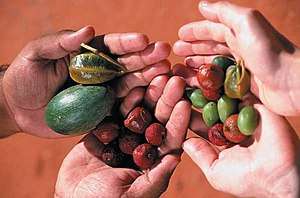 Bush tucker fruits
Bush tucker fruits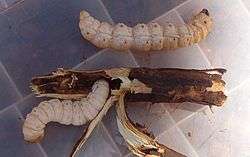
Development of modern Australian cuisine
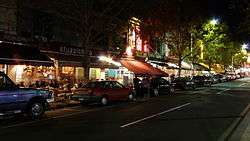
Following the pre-colonial period, British colonisers began arriving with the First Fleet of ships at Sydney harbour in 1788.[14] The diet consisted of "bread, salted meat and tea with lashings of rum (initially from the West Indies but later made from the waste cane of the sugar industry in Queensland)."[15] The British found familiar game in Australia including swan, goose, pigeon and fish, but the new settlers often had difficulty adjusting to the prospect of native fauna as a staple diet.[1]
After initial difficulties, Australian agriculture became a major global producer and supplied an abundance of fresh produce for the local market. Stock grazing (mostly sheep and cattle) are prevalent throughout the continent. Queensland and New South Wales became Australia's main beef cattle producers, while dairy cattle farming is found in the southern states, predominantly in Victoria. Wheat and other grain crops are spread fairly evenly throughout the mainland states. Sugar cane is also a major crop in Queensland and New South Wales. Fruit and vegetables are grown throughout Australia[16] and wheat is a main component of the Australian diet.[17] Today there are over 85,681 farm businesses in Australia, 99 percent of which are locally owned and operated.[18]
Barbecued meat is ubiquitous with Modern Australian cuisine, though it is estimated that more than 10% of Australians are now vegetarian.[19][20]
Fruit and vegetables
Fruit
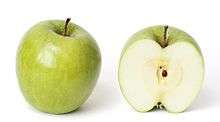
There are many species of Australian native fruits, such as quandong (native peach), wattleseed, muntries / munthari berry, Illawarra plums, riberry, native raspberries, lilli pillies, as well as a range of native citrus species including the Desert Lime and Finger Lime.[21] These usually fall under the category of bush tucker, which is used in some restaurants and in commercial preserves and pickles but not generally well known among Australians due to its low availability.
Australia also has large fruit growing regions in most states for tropical fruits in the north, stone fruits and temperate fruits in the south which has a mediterranean or temperate climate. The Granny Smith variety of apples originated in Sydney in 1868.[22] Another well-known Australian apple variety is the Cripps Pink, known locally and internationally as "Pink Lady" apples, which was first cultivated in 1973.[23]
Fruits cultivated and consumed in Australia include: apples, banana, kiwi fruit, oranges and other citrus, mangoes (seasonally), mandarin, stonefruit, avocado, watermelons, rockmelons, lychees, pears, nectarines, plums, apricots, grapes, melons, papaya (also called pawpaw), pineapple, passionfruit and berries (strawberries, raspberries etc.).[24]
Vegetables
In the temperate regions of Australia vegetables are traditionally eaten seasonally, especially in regional areas, although in urban areas there is large scale importation of fresh produce sourced from around the world by supermarkets and wholesalers for grocery stores, to meet demands for year-round availability. During Spring: artichoke, asparagus, bean shoots, beetroot, broccoli, cabbage, cauliflower, cucumber, leek, lettuce, mushrooms, peas, rhubarb, and spinach. During Summer: capsicum, cucumber, eggplant, squash, tomato, and zucchini.[25]
Meat & poultry
Chicken is the most commonly consumed of all meats or poultry by weight, with approximately 47 kg of chicken consumed by the average Australian per year.[26]
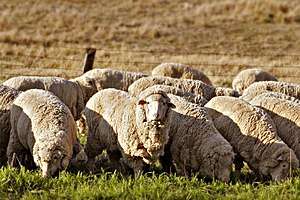
As of July 2018 Australians ate around 25kg of beef per person with beef having a 35% share of fresh meat sales by value, the highest of any fresh meat in 2018-19.[27]
Lamb is very popular in Australia, with roasting cuts (legs and shoulders), chops, and shanks being the most common cuts. Lamb will often form part of either a Sunday roast or a barbecue. It is also commonly found as an ingredient in gyros and doner kebabs, brought by Greek and Turkish immigrants in the 1960s and 1970s. Australia consumes more lamb and mutton than any other country listed by the OECD-FAO (with Kazakhstan in second place). In 2017, Australians consumed an average of 8.5 kilograms (19 lb) per person. By way of comparison, New Zealanders average 3.2 kilograms (7.1 lb) and Americans just 0.4 kilograms (0.88 lb).[28]
Game
Kangaroo meat is available as game in Australia, although it is not among the most commonly eaten meats. In colonial-era recipes, kangaroo was treated much like ox tail, and braised until tender forming a rich gravy. It is available today in various cuts and sausages.[29][30] Kangaroo is however a common commercial dog food in Australia.
Even less commonly eaten forms of game are emu and crocodile.
- Kangaroo meat at a supermarket
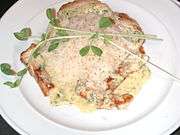 A crocodile dish
A crocodile dish
Fish and seafood
Seafood consumption is increasing, but it is less common in the Australian diet than poultry and beef.[17] Australian cuisine features Australian seafood such as southern bluefin tuna, King George whiting, Moreton Bay bugs, mud crab, jewfish, dhufish (Western Australia) and yabby. Australia is one of the largest producers of abalone and rock lobster.
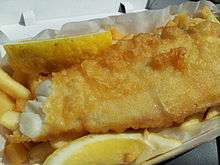
Fish and chips is a take-away food that originated in the United Kingdom and remains popular in Australia.[31] It generally consists of battered deep-fried fish with deep-fried chipped (slab-cut) potatoes. Rather than cod which is more common in the UK, the most popular fish at Australian fish and chips shops, at least in southern Australian states, is flake – a fillet of Gummy shark (Mustelus antarcticus).[32]
Flathead is also a popular sport and table fish found in all parts of Australia. Barramundi is a fish found in northern Australian river systems. Bay lobsters, better known in Australia as Moreton Bay bugs are common in seafood restaurants, or may be served with steak as "surf & turf".
The most common species of the aquaculture industry are: salmon, tuna, oysters, and prawns. Other species include: abalone, freshwater finfish (such as barramundi, Murray cod, silver perch), brackish water or marine finfish (such as barramundi, snapper, yellowtail kingfish, mulloway, groupers), mussels, ornamental fish, marine sponges, mud crab and sea cucumber.[33]
While inland river and lake systems are relatively sparse, they nevertheless provide freshwater game fish and crustacea suitable for dining. Fishing and aquaculture constitute Australia's fifth most valuable agricultural industry after wool, beef, wheat and dairy.[34] Approximately 600 varieties of marine and freshwater seafood species are caught and sold in Australia for both local and overseas consumption. European carp, common in the Murray River as an invasive species, is not considered edible by most Australians despite being common in cuisines across Europe.
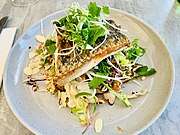 Barramundi
Barramundi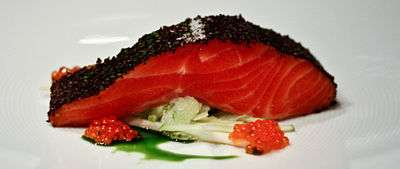 Confit of Tasmanian ocean trout
Confit of Tasmanian ocean trout
Dairy
The nation also has a longstanding dairy industry (virtually from colonisation) and today produces a wide variety of cheeses, yoghurt, milk, cream, and butter products. Australians are high consumers of dairy products, consuming (on average) some 102.4 L of milk per person a year (due in part to Australia's coffee culture), 12.9 kg of cheese, 3.8 kg of butter (a small reduction from previous year, largely for dietary purposes) and 7.1 kg of yoghurt products.[35]
Beverages
Tea
Tea was the hot beverage most commonly consumed in Australia throughout most of its history from the time the earliest British settlers, though coffee has become overall more common since the 1990s.[36] Since the 19th Century, billy tea was a staple drink for those out in the great outdoors and at campsites. Boiling water for tea in a billy over a camp fire and adding a gum leaf for flavouring remains an iconic traditional Australian method for preparing tea.[1] Famously, it was prepared by the ill-fated swagman in the renowned Australian folksong "Waltzing Matilda". Tea and freshly-baked homemade scones are common for afternoon tea between friends and family.
Although Australians often drink tea at home, it has been found that in out-of-home establishments where tea and coffee are sold together, tea accounted for only 2.5% of total sales.
Coffee
Today's Australia has a distinct coffee culture. The coffee industry has grown from independent cafés since the early 20th century. The flat white first became popular in Australia, and its invention is claimed by a Sydneysider.[37][38] The iconic Greek cafés of Sydney and Melbourne were the first to introduce locally roasted coffees in 1910.
In 1952, the first espresso machines began to appear in Australia and a plethora of fine Italian coffee houses were emerging in Melbourne and Sydney. Pelligrini's Espresso Bar and Legend Café often lay claim to being Melbourne's first 'real' espresso bars, opening their doors in 1954 and 1956 respectively. This decade also saw the establishment of one of Australia's most iconic coffee brands, Vittoria, which remains the country's largest coffee maker and distributor. The brand has existed in Australia since 1958, well before it moved to the US.[39]
To this day, coffee chains such as Starbucks have very little market share in Australia, with other homegrown franchises such as the Shingle Inn, Gloria Jean's, The Coffee Club, Dôme, Michel's Patisserie and Zarraffas Coffee also contributing to the smaller coffee chain market share. One reason for this is that unlike in the United States and Asia, Australia already had a developed coffee culture for many decades before coffee chains came to the market.[40]
Other hot beverages
The chocolate and malt powder Milo, which was developed by Thomas Mayne in Sydney in 1934 in response to the Great Depression, is mixed with cold or hot milk to produce a popular beverage. In recent years, Milo has been exported and is also commonly consumed in Southeast Asia even becoming a major ingredient in some desserts produced in the region.[41]
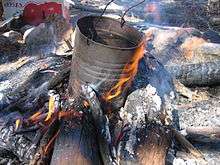 A traditional billycan on a campfire, used to heat water, typically for brewing tea
A traditional billycan on a campfire, used to heat water, typically for brewing tea A flat white with latte art
A flat white with latte art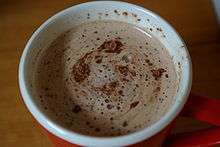 A cup of hot Milo
A cup of hot Milo
Alcohol
Beer in Australia has been popular since colonial times. James Squire is considered to have founded Australia's first commercial brewery in 1798 and the Cascade Brewery in Hobart, Tasmania, has been operating since the early 19th century. Since the 1970s, Australian beers have become increasingly popular globally – with Fosters lager being an iconic export brand. However, Fosters is not a large seller on the local market, with alternatives such as Victoria Bitter & Carlton Draught outselling the popular export. Craft beer is popular, as well as distinctive products from smaller breweries such as Coopers and Little Creatures.[42]
The Australian wine industry is the fifth largest exporter of wine around the world, with 760 million litres a year to a large international export market and contributes $5.5 billion per annum to the nation's economy. Australians consume over 530 million litres annually with a per capita consumption of about 30 litres – 50% white table wine, 35% red table wine.[43] Wine is produced in every state, with more than 60 designated wine regions totalling approximately 160,000 hectares. Australia's wine regions are mainly in the southern, cooler parts of the country, in South Australia, New South Wales, Victoria, and Western Australia. Amongst the most famous wine districts are the Hunter Region, Margaret River, Yarra Valley, and Barossa Valley and among the best known wine producers are Penfolds, Rosemount Estate, Wynns Coonawarra Estate and Lindeman's.[44] In Australia's tropical regions, wine is produced from exotic fruits such as mango, passion fruit and lychees.[45]
Rum served as a currency during the late 18th and early 19th centuries in Australia when metallic currency was in short supply.[46]
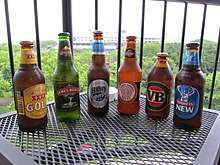 Six stubbies of different Australian beers.
Six stubbies of different Australian beers. Penfolds Grange, 1999, a premium Australian red wine
Penfolds Grange, 1999, a premium Australian red wine
Take-away foods and counter lunches
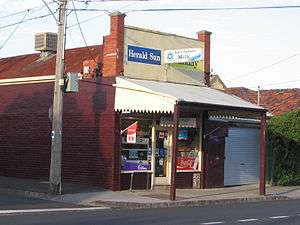
The traditional places to buy take-away food in Australia has long been at a local milk bar, fish and chip shop, or bakery, though these have met with stiff competition from fast food chains and convenience stores in recent decades.
Iconic Australian take-away food (i.e. fast food) includes meat pies, sausage rolls, pasties, Chiko Rolls, and dim sims. Meat pies, sausage rolls, and pasties are often found at a milk bar and bakeries, where they are kept hot in a pie warmer; the pie is also very popular at AFL football matches.[47] Chiko rolls, dim sims and other foods needing to be deep fried, are to be found at fish and chip shops.
The Australian hamburgers and steak sandwiches are also found at fish and chip shops. Australian hamburgers consist of a fried beef patty, served with shredded lettuce and sliced tomato in a (usually toasted) round bread roll or bun. Tomato sauce (similar to ketchup but made with less sugar and less viscous) or barbecue sauce are almost always included. Bacon, cheese and fried onions are also common additions, as is a slice of beetroot and/or a fried egg, with other options including sliced pineapple. Pickles are rarely included, except in burgers from American chains.[48] Steak sandwiches come with the same options, but instead of a beef patty they consist of a thin steak and are served in two slices of toast, not buns.
Barbecued sausages are a common food, particularly at a sausage sizzle, which are commonly found at community and fundraising events. They are served in a slice of white bread, with or without tomato sauce and with the option of adding fried onions. A sausage sizzle at a polling station on any Australian state or Federal election day (both are always held on Saturdays in Australia) has in the 21st Century become known as a Democracy sausage.
Lunch at an Australian pub is called a counter lunch, while the term counter meal is used for either lunch or dinner.[49] Common dishes served at counter lunches and counter meals are steak and chips, chicken parmigiana and chips, a mixed grill (an assortment of grilled meats), and roast lamb or beef with roast vegetables.[50]
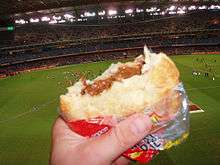 A meat pie at an AFL football match
A meat pie at an AFL football match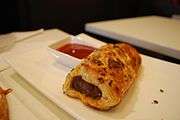 A sausage roll served in-house at a bakery
A sausage roll served in-house at a bakery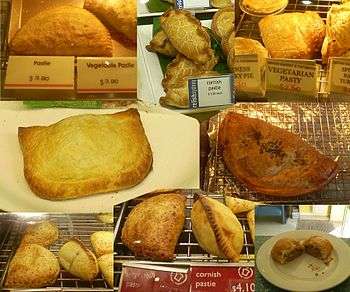 An assortment of pasties
An assortment of pasties Chiko roll in a bag
Chiko roll in a bag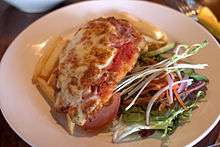 Chicken parmigiana with chips and salad
Chicken parmigiana with chips and salad
Baked goods and desserts
Damper is a traditional Australian soda bread prepared by swagmen, drovers and other travellers. It is a wheat flour based bread, traditionally baked in the coals of a campfire.
Toast is commonly eaten at breakfast. An iconic commercial spread is Vegemite – this is a salty, B vitamin-rich savoury spread made from brewers yeast eaten on buttered toast, commonly at breakfast, or in sandwiches.[51][52] A common children's treat dating back to the 1920s is fairy bread.[53]
A classic Australian biscuit is the ANZAC biscuit, which are often homemade and so-called as they were sent by families and friends to Australian soldiers fighting in Europe and the Dardanelles in the First World War. A popular commercial brand of biscuit are Arnott's Tim Tams.
A classic Aussie cake is the lamington, made from two squares of butter cake or sponge cake coated in an outer layer of chocolate sauce and rolled in desiccated coconut. Another popular cake and dessert dish is the pavlova, a meringue-based dessert, however the origins of this are contested as New Zealand also lays claim to its invention.[54][55]
Regional foods

As well as national icons there are many regional iconic foods.[56]
South Australia has FruChocs, King George whiting, and a range of food of German origin including mettwurst, Bienenstich (beesting), streuselkuchen (German cake)[57] and fritz. The state has its own iconic brands such as Farmers Union Iced Coffee, YoYo biscuits, Balfours frog cakes. Jubilee cake is a specialty of South Australia.[58] In Adelaide, a variant on the meat pie is the pie floater, which is a meat pie served in a bowl of pea soup.
Victoria is famous for its home-grown Melbourne invention, the dim sim.[59] Tasmania has leatherwood honey and abalone.[60] Queensland has Weis Fruit Bar and claims the lamington.[61]
Halal Snack Pack, ("HSP", also known in South Australia as an AB) is a Middle-Eastern inspired dish common at kebab shops around Australia. It consists of doner kebab meat served over hot chips and covered in sauces (such as chilli, garlic, or barbecue sauce).[62]
See also
References
- "Australian food and drink". Cultureandrecreation.gov.au. 23 September 2008. Archived from the original on 22 March 2011. Retrieved 17 September 2011.
- Australian Institute of Health and Welfare, Australia's food & nutrition 2012, 2012, p. 73
- "Vegetable industry". agriculture.gov.au. Department of Agriculture and Water Resources – Commonwealth of Australia. Retrieved 6 December 2018.
- "Modern Australian recipes and Modern Australian food : SBS Food". Sbs.com.au. Retrieved 17 September 2011.
- Weule, Genelle (20 July 2017). "Ancient Indigenous rock shelter rewrites Australia's human history". ABC News. Retrieved 15 December 2018.
- "About Native Australian food". SBS. 1 July 2008. Retrieved 17 March 2017.
- author. "Kangaroo and wallaby". NSW Environment & Heritage. Retrieved 15 December 2018.
- "Grub's up!". Australian Geographic. 14 February 2017. Retrieved 15 December 2018.
- "Aboriginal Weapons". www.mbantua.com.au. Retrieved 15 December 2018.
- Miskelly, Greg (13 November 2017). "Aboriginal people spread native plants by hand: study". ABC News. Retrieved 15 December 2018.
- Wright, Warwick. "Aboriginal Cooking Techniques" (PDF). www.anbg.gov.au. Retrieved 15 December 2018.
- Newling, Jacqui (2015). Eat your history, stories and recipes form Australian kitchens. Sydney, Australia: Sydney Living Museums and NewSouth Publishing. pp. 19–62. ISBN 9781742234687.
- O'Brien, Charmaine (2016). The Colonial Kitchen. USA: Rowman & Littlefield. pp. Chapters 1, 2, 7. ISBN 9781442249813.
- "1788 | Australia's migration history timeline | NSW Migration Heritage Centre". Archived from the original on 5 May 2008. Retrieved 15 December 2018.
- R. Haden, Food Culture in the Pacific Islands, 2009, p. 46
- "Australian farms and farming communities – australia.gov.au". Cultureandrecreation.gov.au. 10 May 2011. Archived from the original on 8 April 2011. Retrieved 17 September 2011.
- "In 30 years, how might climate change affect what Australians eat and drink". Bulletin of the Australian Meteorological and Oceanographic Society. 29 (1): 22–27. 2016.
- Internet, Chirp. "Farm Facts | National Farmers' Federation". www.nff.org.au. Retrieved 15 December 2018.
- Tapsell, L. (2007). "Meat in the context of the whole diet: A social and cuisine perspective". Nutrition & Dietetics. 64: S108–S110.
- Winsor, B. "More than 10% of Australians are now vegetarian". sbs.com.au. SBS. Retrieved 6 December 2018.
- "Archived copy" (PDF). Archived from the original (PDF) on 25 January 2011. Retrieved 20 October 2010.CS1 maint: archived copy as title (link)
- "Granny Smith and her Apples". Archived from the original on 11 August 2007. Retrieved 11 August 2007.
- Cripps, J. E. L.; Richards, L. A.; Mairata, A. M. (1 October 1993). "`Pink Lady' Apple". HortScience. 28 (10): 1057–1057. doi:10.21273/HORTSCI.28.10.1057. ISSN 0018-5345.
- "Horticulture fact sheet". agriculture.gov.au. Department of Agriculture and Water Resources – Commonwealth of Australia. Retrieved 6 December 2018.
- "Vegetable growing in the Central West" (PDF). Dpi.nsw.gov.au. Retrieved 23 January 2018.
- "Facts & Figures - ACMF". The Australian Chicken Meat Federation. Retrieved 24 June 2020.
- "Fast Facts 2019 — Australia's beef industry The off-farm meat value (domestic expenditure plus export value) of the Australian beef industry was approximately $19.6 billion in 2018-19 – up 10% on the 2017-18 period (MLA estimate)" (PDF). Meat & Livestock Australia. Retrieved 24 June 2020.
- Meat consumption, OECD Data. Retrieved 6 December 2016.
- Woodgate, Thomas (3 November 2011). "Australian food: 40 dishes locals like to call their own". CNN Travel. Retrieved 27 July 2015.
- "KIAA – Kangaroo Meat Cuts". Kangaroo-industry.asn.au. Archived from the original on 4 March 2016. Retrieved 17 September 2011.
- "BBC – Ever Wondered Food – History". 18 November 2004. Archived from the original on 18 November 2004.
- "Which Fish for Fish and Chips". The Australian Fish and Chips Awards. Fisheries Research and Development Corporation. Retrieved 28 June 2020.
- "Aquaculture industry in Australia". agriculture.gov.au. Department of Agriculture and Water Resources – Commonwealth of Australia. 2018. Retrieved 17 September 2018.
- "Fisheries Home". DAFF. 13 September 2011. Archived from the original on 25 September 2011. Retrieved 17 September 2011.
- "Dairy Australia – Consumption statistics". Dairyaustralia.com.au. Archived from the original on 3 December 2013. Retrieved 23 January 2018.
- Dan Bolton (12 November 2019). "Choice Reviews Reveal Australian Tea Trends". World Tea News. Retrieved 25 June 2020.
- "How Australian Coffee Took Over—And Why New Zealand Coffee Could Be Next". Vogue. 1 January 2018. Retrieved 10 December 2018.
- Pearlman, Jonathan (28 September 2015). "Who invented the flat white? Row breaks out between Australian and New Zealand cafe owners". ISSN 0307-1235. Retrieved 15 December 2018.
- "Vittoria Coffee". Vittoriacoffee.com. Retrieved 23 January 2018.
- James Braund. "Caffeination: Australia's (obsessive) coffee culture – travel tips and articles". Lonely Planet. Retrieved 17 September 2011.
- "Add Milo to everything this year: Your favourite malty drink is sky-rocketing to hero status". Food24. 11 May 2018. Retrieved 15 December 2018.
- "Changing beer habits to blame for profit decline". ABC News. 23 September 2011. Retrieved 9 December 2011.
- "4307.0.55.001 – Apparent Consumption of Alcohol, Australia, 2010–11". abs.gov.au. Australian Bureau of Statistics. 3 May 2012. Retrieved 20 May 2012.
- "Australia's wine industry". Cultureandrecreation.gov.au. 14 December 2007. Archived from the original on 17 February 2011. Retrieved 17 September 2011.
- "Wineries & Vineyards - Cairns Australia". www.cairns-australia.com. Retrieved 16 February 2020.
- L. Allen, The Encyclopedia of Money, 2009, p. 268
- http://www.australian-information-stories.com/meat-pie.html
- "Australian burger recipe". burgers here and there. 2 March 2011. Retrieved 17 September 2011.
- "1857 First reference to the counter lunch". Australian food history timeline. Retrieved 28 June 2020.
- Callan Boys (10 November 2014). "Ten classic Australian pub foods". The Good Food Guide. Retrieved 28 June 2020.
- "Vegemite turns 90: what's your favourite iconic Australian brand?". ABC. ABC News. 25 October 2013. Retrieved 10 December 2018.
- "Pavlova page". Aussie-info.com. Retrieved 17 September 2011.
- "Meanings and origins of Australian words and idioms", Australian National University. Retrieved 12 August 2016.
- Goldsmith, Susette (12 July 2008). "Pavlova palaver". Noted. New Zealand Listener (Bauer Media Group). Retrieved 12 February 2019.
- Sas, Nick (4 December 2010). "Hands off our pavlova, Kiwis warned". The West Australian. Seven West Media. Retrieved 11 February 2019.
- "Favourite SA Food Icon". Adelaide Today.
- "Fritz – Traditional German Cake Recipe". www.fritzmag.com.au. Retrieved 14 October 2018.
- "Australia's cuisine culture: a history of our food – Australian Geographic". Australian Geographic. 27 June 2014. Retrieved 14 October 2018.
- Brown, Simon Leo (8 February 2016). "Dim sims: The history of a Chinese-Australian icon". ABC News. Retrieved 15 December 2018.
- "Top ten Tasmanian food specialities". www.tasmaniatopten.com. Retrieved 14 October 2018.
- "Q150 icons list". Brisbane Times. 10 June 2009. Retrieved 14 October 2018.
- "Your Local Kebab Shop Is Now Trending, Introducing Your New Facebook Group Obsession". MTV. 14 March 2016. Retrieved 30 April 2016.
Further reading
- Newling, J., 2015. Eat Your History: Stories and Recipes from the Australian Kitchen. Sydney Living Museums.
- O'Brien, C., 2016. The Colonial Kitchen: Australia 1788–1901. Rowman & Littlefield.
- O'Connell, J., 2017. A Timeline of Australian Food: From Mutton to Masterchef. NewSouth Publishing.
- Santich, B., 2006. "The high and the low: Australian cuisine in the late nineteenth and early twentieth centuries". Journal of Australian studies, 30 (87), pp. 37–49.
External links
| Wikimedia Commons has media related to Cuisine of Australia. |
| Wikibooks Cookbook has a recipe/module on |
_(cropped).jpg)

